Should “Green” Be Precise? The Effect of Information Presentation on Purchasing Intention of Green Products
Abstract
:1. Introduction
2. Theories and Hypotheses
2.1. Information Presentation Modes
2.2. Green Products
2.3. Information Presentation of Green Products
2.4. Green Trust
2.5. Product Types
3. Methodology
3.1. Study 1
3.1.1. Design and Participants
3.1.2. Procedures
3.1.3. Results and Discussion
3.2. Study 2
3.2.1. Design and Participants
3.2.2. Procedures
3.2.3. Results and Discussion
3.3. Study 3
3.3.1. Design and Participants
3.3.2. Procedures
3.3.3. Results and Discussion
4. Discussion
4.1. Theoretical Contributions
4.2. Practical Implications
4.3. Limitations and Future Directions
Author Contributions
Funding
Institutional Review Board Statement
Informed Consent Statement
Data Availability Statement
Conflicts of Interest
References
- Kim, H.; Rao, A.R.; Lee, A.Y. It’s Time to Vote: The Effect of Matching Message Orientation and Temporal Frame on Political Persuasion. J. Consum. Res. 2009, 35, 877–889. [Google Scholar] [CrossRef]
- Koester, A. ‘About Twelve Thousand or So’: Vagueness in North American and UK Offices. In Vague Language Explored; Springer: Berlin/Heidelberg, Germany, 2007; pp. 40–61. [Google Scholar]
- Featherman, M.; Jia, S.Z.; Califf, C.B.; Hajli, N. The impact of new technologies on consumers beliefs: Reducing the perceived risks of electric vehicle adoption. Technol. Forecast. Soc. Chang. 2021, 169, 18. [Google Scholar] [CrossRef]
- Zhu, W.; Li, J. A Pragmatic Study on the Functions of Vague Language in Commercial Advertising. Engl. Lang. Teach. 2013, 6, 103–112. [Google Scholar] [CrossRef]
- Gil-Perez, I.; Rebollar, R.; Lidon, I. Without words: The effects of packaging imagery on consumer perception and response. Curr. Opin. Food Sci. 2020, 33, 69–77. [Google Scholar] [CrossRef]
- Xie, G.-X.; Kronrod, A. Is the Devil in the Details? J. Advert. 2012, 41, 103–117. [Google Scholar] [CrossRef]
- Wei, J.M. Codeswitching in campaigning discourse: The case of Taiwanese president Chen Shui-bian. Lang. Linguist. 2003, 4, 139–165. [Google Scholar]
- Pena-Marin, J.; Wu, R.M. Disconfirming Expectations: Incorrect Imprecise (vs. Precise) Estimates Increase Source Trustworthiness and Consumer Loyalty. J. Consum. Psychol. 2019, 29, 623–641. [Google Scholar] [CrossRef]
- Miller, E.G.; Kahn, B.E. Shades of meaning: The effect of color and flavor names on consumer choice. J. Consum. Res. 2005, 32, 86–92. [Google Scholar] [CrossRef]
- Iyer, E.; Banerjee, S. Anatomy of green advertising. Adv. Consum. Res. 1993, 20, 494–501. [Google Scholar]
- Chang, H.; Zhang, L.L.; Xie, G.X. Message framing in green advertising: The effect of construal level and consumer environmental concern. Int. J. Advert. 2015, 34, 158–176. [Google Scholar] [CrossRef]
- Du, Y.; Wang, H. Green Innovation Sustainability: How Green Market Orientation and Absorptive Capacity Matter? Sustainability 2022, 14, 8192. [Google Scholar] [CrossRef]
- Dahlquist, S.H. How green product demands influence industrial buyer/seller relationships, knowledge, and marketing dynamic capabilities. J. Bus. Res. 2021, 136, 402–413. [Google Scholar] [CrossRef]
- Yang, J.Y.; Roh, T. Open for Green Innovation: From the Perspective of Green Process and Green Consumer Innovation. Sustainability 2019, 11, 3234. [Google Scholar] [CrossRef]
- Nittala, R. Green Consumer Behavior of the Educated Segment in India. J. Int. Consum. Mark. 2014, 26, 138–152. [Google Scholar] [CrossRef]
- Chen, Y.-S.; Chang, C.-H. Greenwash and Green Trust: The Mediation Effects of Green Consumer Confusion and Green Perceived Risk. J. Bus. Ethics 2012, 114, 489–500. [Google Scholar] [CrossRef]
- Nguyen, T.T.H.; Yang, Z.; Nguyen, N.; Johnson, L.W.; Cao, T.K. Greenwash and Green Purchase Intention: The Mediating Role of Green Skepticism. Sustainability 2019, 11, 2653. [Google Scholar] [CrossRef]
- Morel, M.; Kwakye, F. Green Marketing: Consumers Attitude towards Eco-Friendly Products and Purchase Intention in the Fast Moving Consumer Goods (FMCG) Sector. Master’s Thesis, Umeå University, Umeå, Sweden, 2012. [Google Scholar]
- Baumann, C.; Hamin, H.; Chong, A. The role of brand exposure and experience on brand recall Product durables vis-a-vis FMCG. J. Retail. Consum. Serv. 2015, 23, 21–31. [Google Scholar] [CrossRef]
- Park, C.W.; Lessig, V.P. Judgmental Rules and Stages of the Familiarity Curve: Promotional Implications. J. Advert. 1977, 6, 10–16. [Google Scholar] [CrossRef]
- Luhmann, N. Trust and Power; John Wiley & Sons: Hoboken, NJ, USA, 1982. [Google Scholar]
- Hutton, J.G. A study of brand equity in an organizational-buying context. J. Prod. Brand Manag. 1997, 6, 428–439. [Google Scholar] [CrossRef]
- Rishi, B. Determinants of Brand Trust for FMCG Products with Special Reference to Shampoos Category. Asia-Pac. J. Manag. Res. Innov. 2013, 9, 221–227. [Google Scholar] [CrossRef]
- Zhou, K.Z.; Nakamoto, K. How do enhanced and unique features affect new product preference? The moderating role of product familiarity. J. Acad. Mark. Sci. 2007, 35, 53–62. [Google Scholar] [CrossRef]
- Vallacher, R.R.; Wegner, D.M. A Theory of Action Identification; Psychology Press: London, UK, 2014. [Google Scholar]
- Wegner, D.M. The emergence of action. J. Personal. Soc. Psychol. 1984, 46, 269–279. [Google Scholar] [CrossRef]
- Diemand-Yauman, C.; Oppenheimer, D.M.; Vaughan, E.B. Fortune favors the bold (and the Italicized): Effects of disfluency on educational outcomes. Cognition 2011, 118, 111–115. [Google Scholar] [CrossRef] [PubMed]
- van Rompay, T.J.L.; Veltkamp, M. Product Packaging Metaphors: Effects of Ambiguity and Explanatory Information on Consumer Appreciation and Brand Perception. Psychol. Mark. 2014, 31, 404–415. [Google Scholar] [CrossRef]
- Mishra, H.; Shiv, B.; Nayakankuppam, D. The Blissful Ignorance Effect: Pre- versus Post-action Effects on Outcome Expectancies Arising from Precise and Vague Information. J. Consum. Res. 2008, 35, 573–585. [Google Scholar] [CrossRef]
- Qiu, L.; Jie, X.W.; Wang, Y.N.; Zhao, M.J. Green product innovation, green dynamic capability, and competitive advantage: Evidence from Chinese manufacturing enterprises. Corp. Soc. Responsib. Environ. Manag. 2020, 27, 146–165. [Google Scholar] [CrossRef]
- Ottman, J.A.; Stafford, E.R.; Hartman, C.L. Avoiding Green Marketing Myopia: Ways to Improve Consumer Appeal for Environmentally Preferable Products. Environ. Sci. Policy Sustain. Dev. 2006, 48, 22–36. [Google Scholar] [CrossRef]
- Gurău, C.; Carrigan, M.; Ranchhod, A. International green marketing: A comparative study of British and Romanian firms. Int. Mark. Rev. 2005, 22, 547–561. [Google Scholar] [CrossRef]
- Chen, M.-Y.; Chiu, C.-I. Go green: How to influence the perceived effectiveness of a green product? Int. J. Advert. 2016, 35, 622–641. [Google Scholar] [CrossRef]
- da Luz, V.V.; Mantovani, D.; Nepomuceno, M.V. Matching green messages with brand positioning to improve brand evaluation. J. Bus. Res. 2020, 119, 25–40. [Google Scholar] [CrossRef]
- Machova, R.; Ambrus, R.; Zsigmond, T.; Bako, F. The Impact of Green Marketing on Consumer Behavior in the Market of Palm Oil Products. Sustainability 2022, 14, 1364. [Google Scholar] [CrossRef]
- Holbrook, M.B. Beyond Attitude Structure: Toward the Informational Determinants of Attitude. J. Mark. Res. 1978, 15, 545–556. [Google Scholar] [CrossRef]
- Liu, X.; Wang, C.; Shishime, T.; Fujitsuka, T. Sustainable consumption: Green purchasing behaviours of urban residents in China. Sustain. Dev. 2012, 20, 293–308. [Google Scholar] [CrossRef]
- Luo, B.; Sun, Y.; Shen, J.; Xia, L. How does green advertising skepticism on social media affect consumer intention to purchase green products? J. Consum. Behav. 2020, 19, 371–381. [Google Scholar] [CrossRef]
- Huang, X.; Ge, J. Electric vehicle development in Beijing: An analysis of consumer purchase intention. J. Clean. Prod. 2019, 216, 361–372. [Google Scholar] [CrossRef]
- Komiak, S.X.; Benbasat, I. Understanding Customer Trust in Agent-Mediated Electronic Commerce, Web-Mediated Electronic Commerce, and Traditional Commerce. Inf. Technol. Manag. 2004, 5, 181–207. [Google Scholar] [CrossRef]
- Swan, J.E.; Bowers, M.R.; Richardson, L.D. Customer Trust in the Salesperson. J. Bus. Res. 1999, 44, 93–107. [Google Scholar] [CrossRef]
- Hong, I.B.; Cha, H.S. The mediating role of consumer trust in an online merchant in predicting purchase intention. Int. J. Inf. Manag. 2013, 33, 927–939. [Google Scholar] [CrossRef]
- Lee, J.; Park, D.H.; Han, I. The different effects of online consumer reviews on consumers’ purchase intentions depending on trust in online shopping malls. Internet Res. 2011, 21, 187–206. [Google Scholar] [CrossRef]
- Harris, L.C.; Goode, M.M.H. Online servicescapes, trust, and purchase intentions. J. Serv. Mark. 2010, 24, 230–243. [Google Scholar] [CrossRef]
- Chen, Y.-S.; Lin, C.-Y.; Weng, C.-S. The Influence of Environmental Friendliness on Green Trust: The Mediation Effects of Green Satisfaction and Green Perceived Quality. Sustainability 2015, 7, 10135–10152. [Google Scholar] [CrossRef]
- Kim, J.; Fairclough, S.; Dibrell, C. Attention, Action, and Greenwash in Family-Influenced Firms? Evidence From Polluting Industries. Organ. Environ. 2017, 30, 304–323. [Google Scholar] [CrossRef]
- Ganesan, S. Determinants of Long-Term Orientation in Buyer-Seller Relationships. J. Mark. 2018, 58, 1–19. [Google Scholar] [CrossRef]
- Mayer, R.C.; Davis, J.H.; Schoorman, F.D. An Integrative Model of Organizational Trust. Acad. Manag. Rev. 1995, 20, 709–734. [Google Scholar] [CrossRef]
- Xiao, Z.; Wang, Y.; Guo, D. Will Greenwashing Result in Brand Avoidance? A Moderated Mediation Model. Sustainability 2022, 14, 7204. [Google Scholar] [CrossRef]
- Gershoff, A.D.; Frels, J.K. What Makes It Green? The Role of Centrality of Green Attributes in Evaluations of the Greenness of Products. J. Mark. 2015, 79, 97–110. [Google Scholar] [CrossRef]
- Chen, Y.S. Towards Green Loyalty: Driving from Green Perceived Value, Green Satisfaction, and Green Trust. Sustain. Dev. 2013, 21, 294–308. [Google Scholar] [CrossRef]
- Perera, L.C.R.; Chaminda, J.W.D. Corporate Social Responsibility and Product Evaluation: The Moderating Role of Brand Familiarity. Corp. Soc. Responsib. Environ. Manag. 2013, 20, 245–256. [Google Scholar] [CrossRef]
- Jung, I.N.; Sharma, A.; Mattila, A.S. The impact of supermarket credibility on purchase intention of novel food. J. Retail. Consum. Serv. 2022, 64, 102754. [Google Scholar] [CrossRef]
- Hosmer, L.T. Trust: The Connecting Link between Organizational Theory and Philosophical Ethics. Acad. Manag. Rev. 1995, 20, 379–403. [Google Scholar] [CrossRef]
- Kumar, N.; Scheer, L.K.; Steenkamp, J.-B.E.M. The Effects of Supplier Fairness on Vulnerable Resellers. J. Mark. Res. 2018, 32, 54–65. [Google Scholar] [CrossRef]
- Gefen, D. E-commerce: The role of familiarity and trust. Omega 2000, 28, 725–737. [Google Scholar] [CrossRef]
- Heinzle, S.L.; Wustenhagen, R. Dynamic Adjustment of Eco-labeling Schemes and Consumer Choice—The Revision of the EU Energy Label as a Missed Opportunity? Bus. Strategy Environ. 2012, 21, 60–70. [Google Scholar] [CrossRef]
- Chiou, L.; Tucker, C.E. How Do Restrictions on Advertising Affect Consumer Search? Manag. Sci. 2022, 68, 866–882. [Google Scholar] [CrossRef]
- Dodds, W.B.; Monroe, K.B.; Grewal, D. Effects of Price, Brand, and Store Information on Buyers’ Product Evaluations. J. Mark. Res. 2018, 28, 307–319. [Google Scholar] [CrossRef]
- Hayes, A.F. Introduction to Mediation, Moderation, and Conditional Process Analysis: A Regression-Based Approach; Guilford Publications: New York, NY, USA, 2017. [Google Scholar]
- Lee, A.Y.; Aaker, J.L. Bringing the frame into focus: The influence of regulatory fit on processing fluency and persuasion. J. Personal. Soc. Psychol. 2004, 86, 205–218. [Google Scholar] [CrossRef]
- Sar, S.; Anghelcev, G. Congruity between mood and message regulatory focus enhances the effectiveness of anti drinking and driving advertisements: A global versus local processing explanation. Int. J. Advert. 2015, 34, 421–446. [Google Scholar] [CrossRef]
- Yoo, J.; Kim, M. The effects of online product presentation on consumer responses: A mental imagery perspective. J. Bus. Res. 2014, 67, 2464–2472. [Google Scholar] [CrossRef]
- Li, G.X.; Yang, L.F.; Zhang, B.J.; Li, X.X.; Chen, F.Y. How do environmental values impact green product purchase intention? The moderating role of green trust. Environ. Sci. Pollut. Res. 2021, 28, 46020–46034. [Google Scholar] [CrossRef]
- Khan, S.N.; Mohsin, M. The power of emotional value: Exploring the effects of values on green product consumer choice behavior. J. Clean. Prod. 2017, 150, 65–74. [Google Scholar] [CrossRef]
- Cacioppo, J.T.; Petty, R.E.; Kao, C.F.; Rodriguez, R. Central and peripheral routes to persuasion: An individual difference perspective. J. Personal. Soc. Psychol. 1986, 51, 1032–1043. [Google Scholar] [CrossRef]
- Hosseini-Motlagh, S.-M.; Ebrahimi, S.; Jokar, A. Sustainable supply chain coordination under competition and green effort scheme. J. Oper. Res. Soc. 2019, 72, 304–319. [Google Scholar] [CrossRef]
- Pals, H.; McColl, R.; Schultz, D.E.; Kerr, G.; Kitchen, P.J. The elaboration likelihood model: Review, critique and research agenda. Eur. J. Mark. 2014, 48, 2033–2050. [Google Scholar] [CrossRef]
- Yoon, S.; Kim, Y.; Baek, T.H. Effort investment in persuasiveness: A comparative study of environmental advertising in the United States and Korea. Int. J. Advert. 2016, 35, 93–105. [Google Scholar] [CrossRef]
- Hidalgo-Baz, M.; Martos-Partal, M.; Gonzalez-Benito, O. Is advertising helpful for organic businesses? Differential effects of packaging claims. Int. J. Advert. 2017, 36, 542–561. [Google Scholar] [CrossRef]
- Kim, Y.; Yun, S.; Lee, J.; Ko, E. How consumer knowledge shapes green consumption: An empirical study on voluntary carbon offsetting. Int. J. Advert. 2016, 35, 23–41. [Google Scholar] [CrossRef]
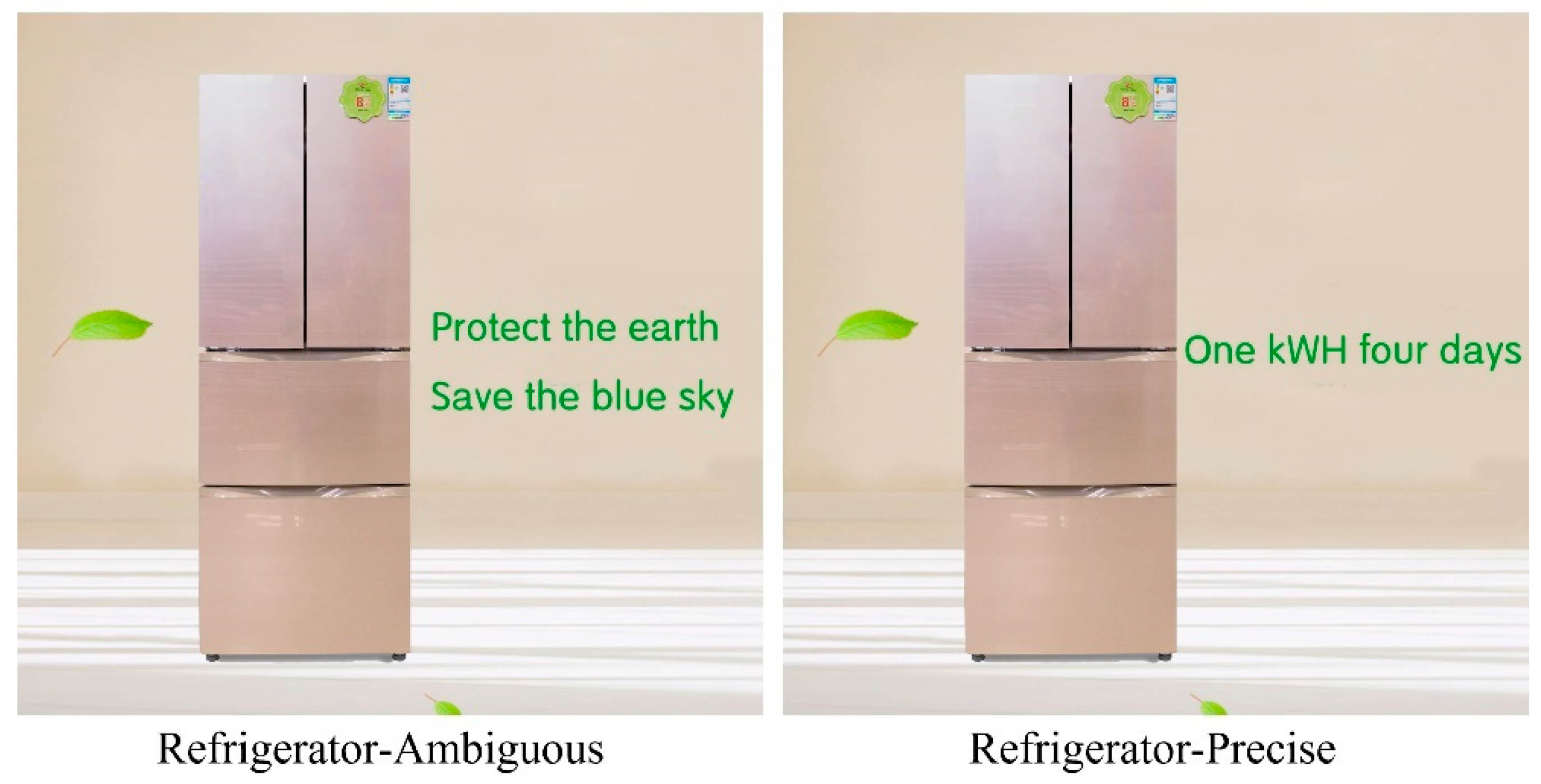
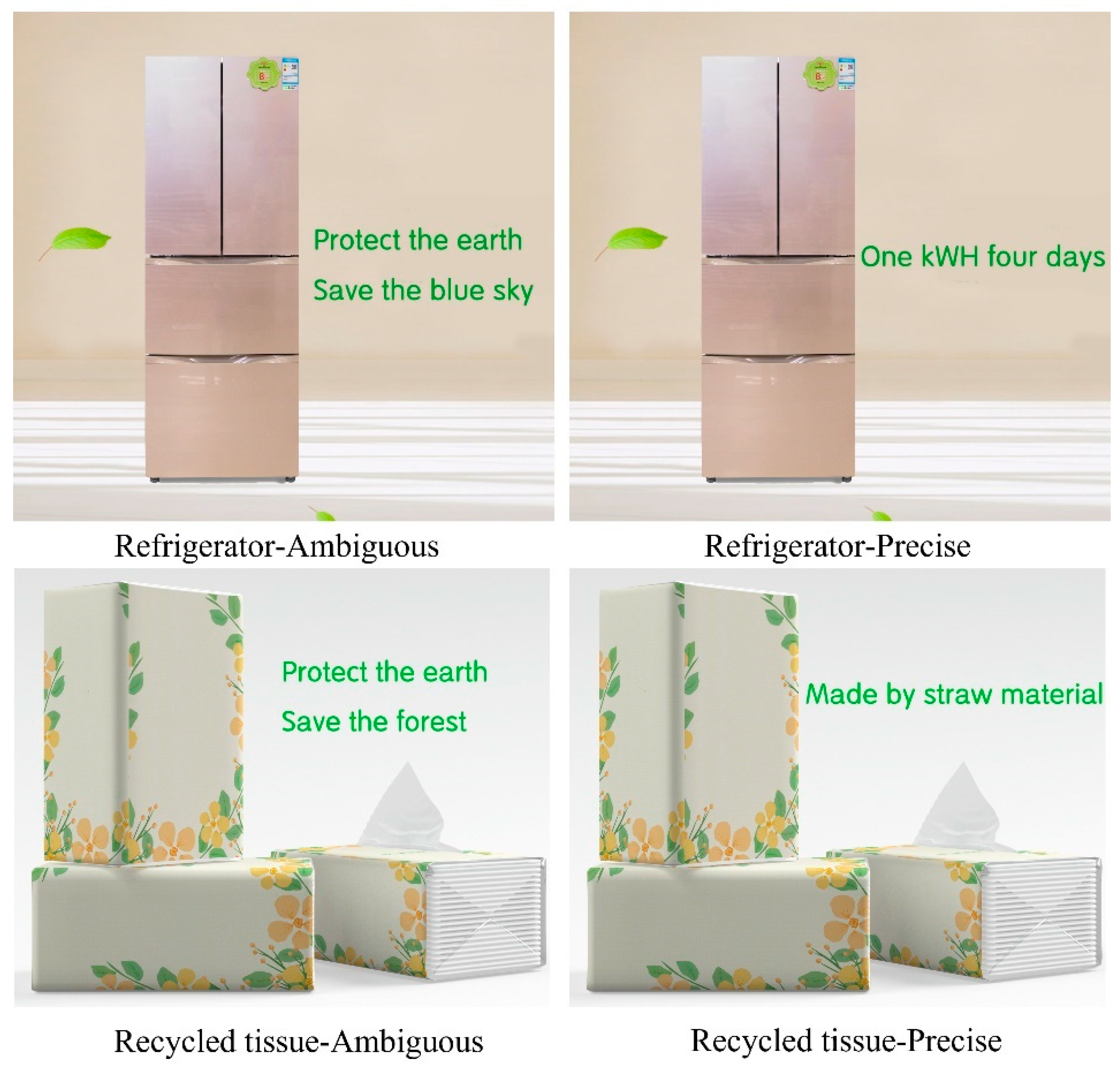
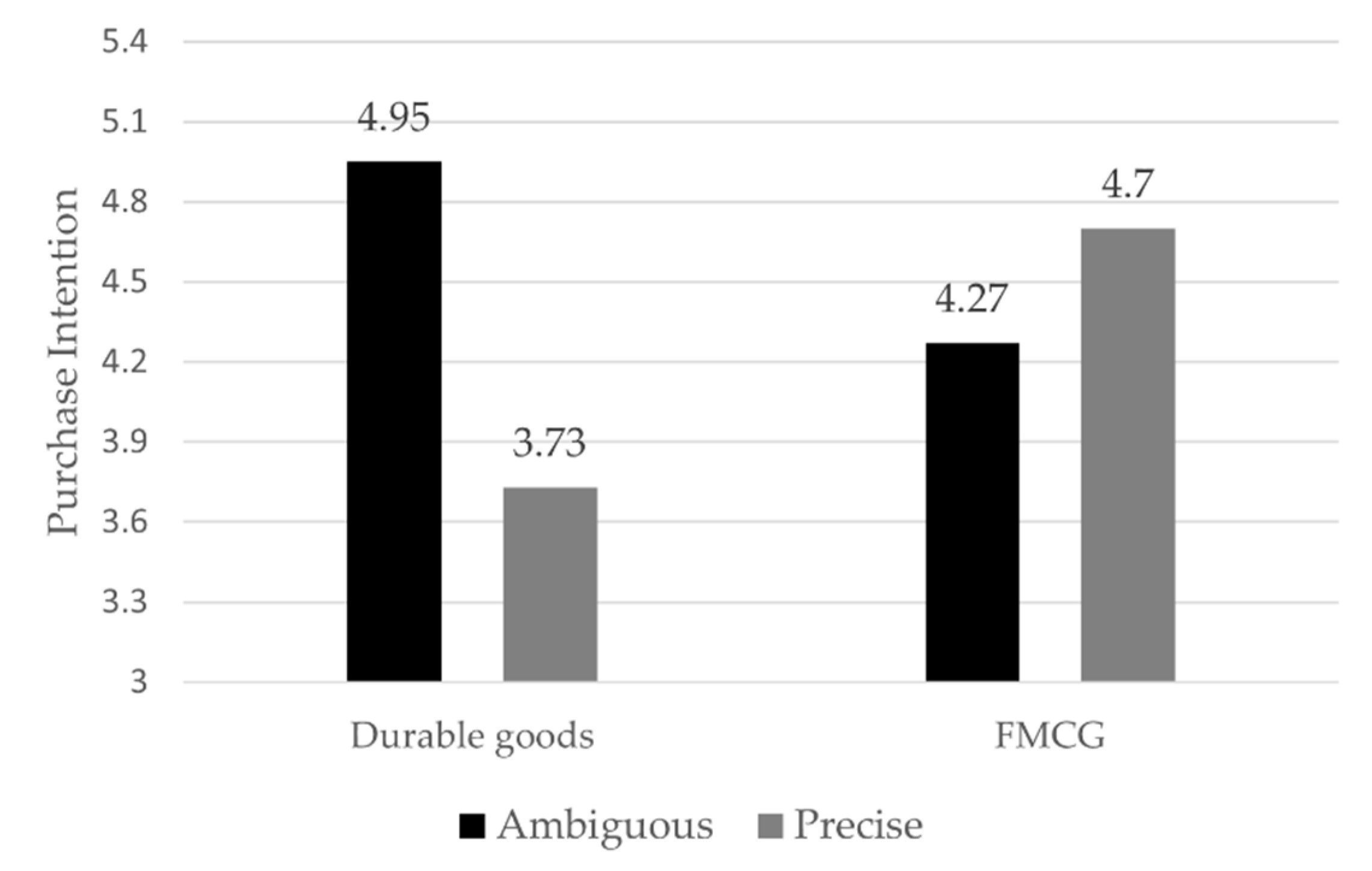
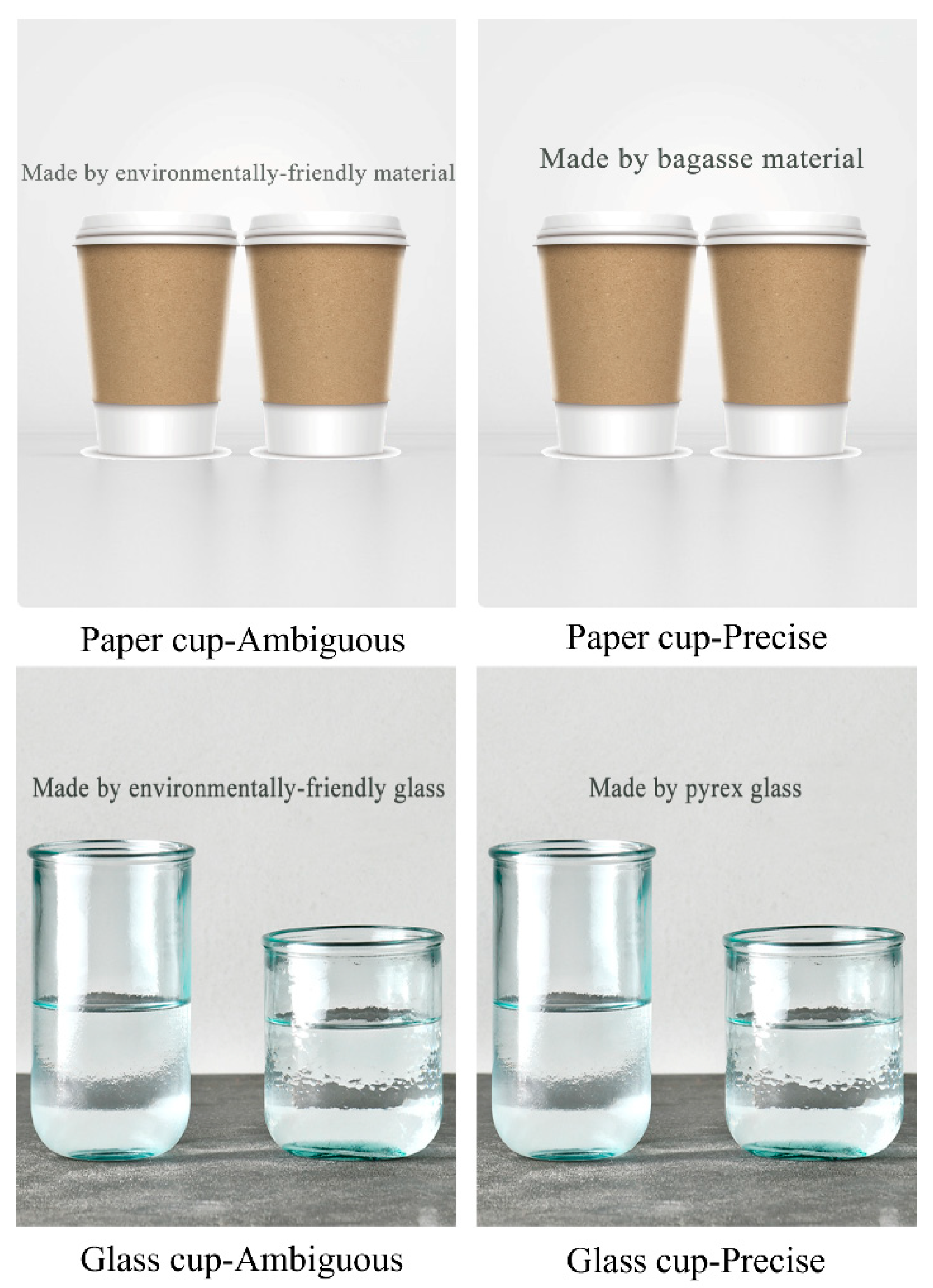
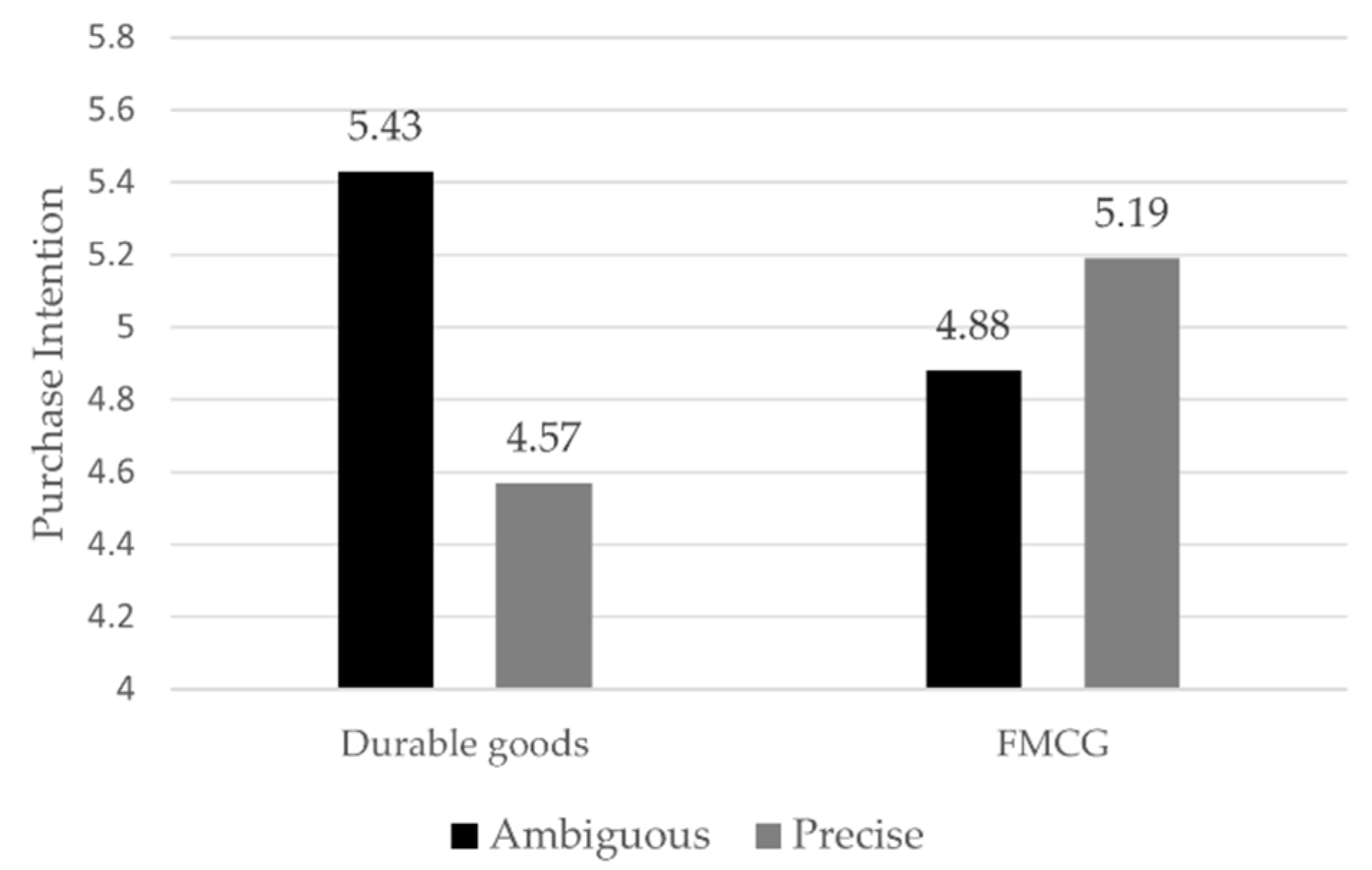
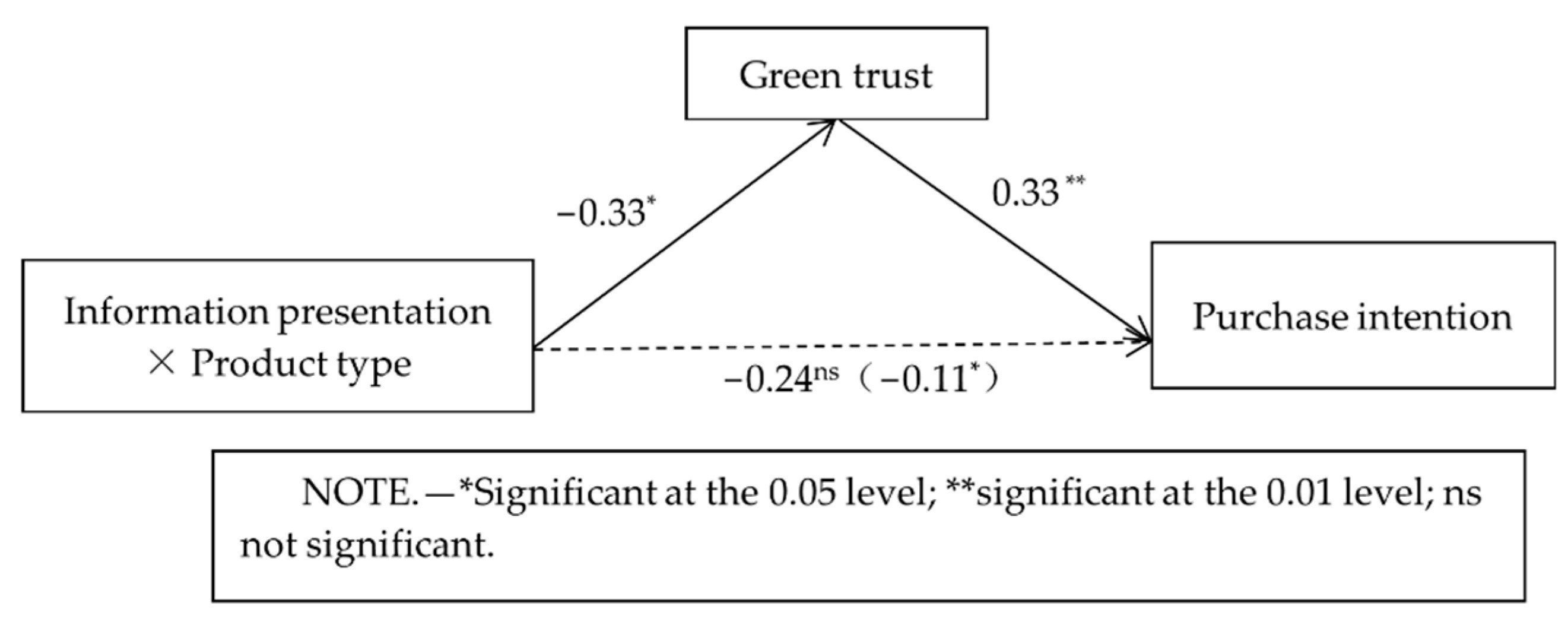
Publisher’s Note: MDPI stays neutral with regard to jurisdictional claims in published maps and institutional affiliations. |
© 2022 by the authors. Licensee MDPI, Basel, Switzerland. This article is an open access article distributed under the terms and conditions of the Creative Commons Attribution (CC BY) license (https://creativecommons.org/licenses/by/4.0/).
Share and Cite
Liang, S.; Zhang, M.; Chu, Y.; He, L. Should “Green” Be Precise? The Effect of Information Presentation on Purchasing Intention of Green Products. Sustainability 2022, 14, 10291. https://doi.org/10.3390/su141610291
Liang S, Zhang M, Chu Y, He L. Should “Green” Be Precise? The Effect of Information Presentation on Purchasing Intention of Green Products. Sustainability. 2022; 14(16):10291. https://doi.org/10.3390/su141610291
Chicago/Turabian StyleLiang, Shichang, Min Zhang, Yuxuan Chu, and Lingling He. 2022. "Should “Green” Be Precise? The Effect of Information Presentation on Purchasing Intention of Green Products" Sustainability 14, no. 16: 10291. https://doi.org/10.3390/su141610291
APA StyleLiang, S., Zhang, M., Chu, Y., & He, L. (2022). Should “Green” Be Precise? The Effect of Information Presentation on Purchasing Intention of Green Products. Sustainability, 14(16), 10291. https://doi.org/10.3390/su141610291






